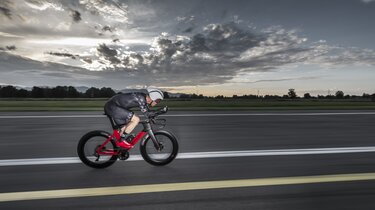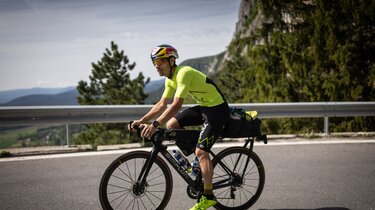

ICE 2 ICE – the hunt for a world record
Less than 100 days from Alaska to Patagonia on a SIMPLON PRIDE. Michael Strasser in an exclusive interview about the ICE 2 ICE project.
ICE 2 ICE: with a PRIDE bike from Alaska to Patagonia
The hottest day: +51 degrees Celsius. Wind speeds of up to 100 kilometres per hour. Longest waiting time at the border: two hours. On the way from Alaska to Patagonia, Michael Strasser and his SIMPLON PRIDE bike had to endure a couple of hardships but he never lost sight of his goal: breaking the world record of Scotsman Dean Stott.
And Michael Strasser did it: In 84 days, 11 hours and 50 minutes, he covered the incredible distance of 22,624 kilometres and 169,738 metres of elevation gain on his bike. His “ICE2ICE” world record was recognised by the Guinness Book of World Records.
In the interview, Michael Strasser lets us in on what his preparation, his set-backs and positive experiences looked like on the way to an astonishing world record.
Planning and preparation are everything
You write that the preparation for the ICE2ICE took you two years. How do you plan a major project like that?
I completely underestimated the project development itself this time. For two years, I put every bit of extra energy into the organisation of it – alongside my regular training. If my girlfriend Kerstin hadn’t supported me around the clock, it wouldn’t have been possible in 2018. Because the execution is restricted to a climatically-limited time window …
What did your mental preparation look like?
I already rode through Africa in 2016 so I had somewhat of an idea of how incredibly hard it would be. But I also devised a plan of attack: I dissect every major project into smaller and more tangible parts. I ride from the first 100 kilometres to the next and the next. And I mature along with my projects. Before going to Africa, I couldn’t have imagined spending 35 days and 11,000 kilometres on my bike. But then, it somehow all worked out …
I’m a lot prouder of my mental performance than of the physical accomplishments. There are lots of physically fit riders. I guess I stand out because of my willingness to make sacrifices and the readiness to “destroy” myself over long periods of time.
On the way to a world record
Did you have to endure any setbacks along the way?
Oh, there were many! I’m an almost pathological optimiser. The only thing that really matters is to get back on and continue, though. Even when you start questioning if this all still makes sense. For instance, when you have 3,000 kilometres of strong headwinds in Peru – with top speeds of 50 kilometres per hour. Here in Austria, nobody would ride a bicycle in conditions like that …
Were there any close calls?
The really dangerous situations always happen in traffic: In Mexico, I nearly got hit by a truck. The only thing that saved me was jumping into the ditch. It took me days to get over this experience and I was afraid to ride at night. But it seems like my life wasn’t supposed to end just then and there, so I tried to ignore those feelings.
What does your diet look like during such an incredibly strenuous project?
I often drink high-caloric sports bars blended with water or almond milk. That makes it easy to eat while riding and it doesn’t cost me a lot of effort.
Did you ever feel perfectly prepared for the world record – mentally and physically?
Things are never perfect, but I never had any major injuries or illnesses. You can only tolerate these kinds of projects, if you’ve continually trained for them over many years. I love “block training”. In winter, I do a lot with touring skis – “Everesting” challenges, for instance. You try to cover 8,848 metres of elevation gain in one go (10 times up the mountain and back down). And then there was my training on the bike … but I never did more than 300 kilometres or 1,000 kilometres per week during my preparation.
The “equipment”
You started – and finished – your journey on a SIMPLON bike. The bike was a faithful companion throughout. Which SIMPLON bike did you decide on and why?
The Guinness World Records regulations don’t let you switch bikes, so I had to decide on one. At the same time, I knew that I would be riding on gravel for the first 800 kilometres in Alaska. And I also knew there would be many headwind passages in South America – so, aerodynamics were really important to me. I tried a few models beforehand. The PRIDE motivated and impressed me right away – a bike that just doesn’t let you go slow. The PRIDE always seems to be striving to go faster.
How would you characterise the PRIDE?
Full of drive, fast, aerodynamic, a little stubborn (but that’s also my best and worst trait), durable … and you shouldn’t underestimate its appearance: I just love the way it looks!
Strasser in a character check
How would you describe yourself in five words?
Authentic, goal-oriented, stubborn (my best and worst trait), deliberate and down to earth.
You’re an ambitious guy. Does that trait mean you’re sometimes your own worst enemy?
You should never lose sight of staying grounded, critically reflect on your actions and remain authentic. I never put an act on for anyone.
What can other athletes learn from you?
All you can do is work on your weaknesses, or search for your strengths and build on those. I prefer the latter option.
The “Racing 4 Charity” fund-raising campaign
The ICE2ICE project was combined with the “Racing 4 Charity” fund-raising campaign – how well was that received?
The campaign was a resounding success! I wanted to donate one euro per kilometre that I rode – that would have been 23,000 euros. In the end, more than 50,000 euros were raised for the charity. Additionally, my dedication won me the title of “Sportler mit Herz des Jahres 2018” (athlete with heart of the year 2018). A nice symbol of recognition for my efforts and the efforts of the whole team.
Last but not least
What advice would you give others that want to attempt a similar endeavour?
Only do it if you are ready to sacrifice a lot and to place all your bets on one card. Nobody sees all the hours of training in winter, in the rain, during bad weather conditions. All that people see is the tip of the iceberg – but below the surface, there’s a giant chunk of work that needs to be accomplished …
Many years of persistent training! I have “worked” on the bike a lot for more than twelve years already and completely constructed my life around it. I quit my job as an architect to focus on training and regeneration. You’ve got to be aware of that.
ICE2ICE – the hard facts:
- coldest day: –4°C in Patagonia
- hottest day: +51°C in Texas (USA)
- shortest day: 170 km in Peru with headwinds of 50 km/h (storm)
- longest day: 461 km (day of the arrival at the finish in Ushuaia)
- top average speed per day: 31,7 km/h on 403 km
- lowest average speed per day: 18,9 km/h on 345 km
- max. elevation gain per day: 5,300 m
- max. altitude: 3,863 m
- max. amount of fluids consumed per day: 8.5 litres
- min. amount of fluids consumed per day: 1.5 litres (during constant rain lead to dehydration)
- calorie intake: approx. 4.500 kcal
- top wind speeds: up to 100 km/h
- shortest waiting time at the border: 15 min
- longest waiting time at the border: 15 h
- the highest number of borders passed within a week: 5 (in Central America)
- top speed on gravel: 83 km/h
- top speed on asphalt: 94 km/h













